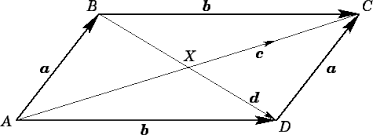Question #56ff1
1 Answer
With the given measures of 3 and 4 for diagonals and one parallel side 5, parallelogram can not exist.
Explanation:

ABCD is a parallelogram with parallel sides a & b as in the above figure.
Shorter diagonal is d and longer one c
condition 1 : In a triangle, sum of any two sides must be greater than the third side.
Condition 2 : a) In an acute angle triangle, sum of the squares of the two smaller sides will be less than the square of the third side.
b) In a right angle triangle,
c) In an obtuse angle triangle, sum of the squares of the smaller two sides must be less than the square of the third side.
Let's conider triangle ACD with sides a, b, c
It is an obtuse angle triangle as
But given b = 5, Hence AC = c must be greater than b and hence with diagonal value 3 or 4, the parallelogram can not exist.
